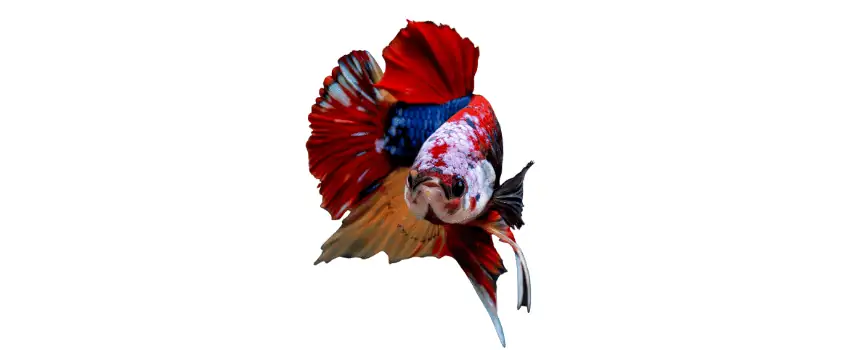Koi betta fish are a variety of the Betta splendens complex.
More specifically, they are a variety of marbled betta.
This betta variety was created by Orville Gulley, a betta breeder, in the early 1970s. The koi betta fish came about through a genetic mutation and years of selective breeding.
This beautiful betta species features a combination of colors similar to a koi fish’s.
Its coloring and patterns result from a “jumping gene” present in the variety.
This type of gene can move from one chromosome to another. It causes koi betta fish to sometimes change colors over time.
Table of Contents
Appearance

There are seven different types of koi betta fish:
- Galaxy koi betta
- Koi plakat betta fish
- Fancy koi betta fish
- Candy koi betta fish
- Tiger koi betta fish
- Nemo plakat betta fish
This wide variety makes Koi bettas an exciting option for betta keepers.
A note on sexual dimorphism in bettas: Since bettas are sexually dimorphic, males and females have different appearances.
Male bettas are almost always more vibrant and colorful than their female counterparts.
They also have longer, more impressive fins and tails. Finally, males tend to grow larger than females.
Galaxy Koi Betta
This is a very common variation of Koi bettas.
Galaxy koi bettas boast vivid colors, with males covered in iridescent red and blue scales.
Long fins and a slender body complement this betta’s already striking appearance.
Koi Plakat Betta Fish
This Koi betta variety is rather common.
It features five or more different colors.
Compared to galaxy kois, this variety has more cellophane coloring and more iridescent scales. Its fins and tail are also shorter than those of galaxy kois.
Fancy Koi Betta Fish
The fancy koi betta has three different colors.
Its color patterns include red, blue, black, and white.
Candy Koi Betta Fish
The Candy Koi betta can have a variety of vivid colors: black, red, blue, and/or yellow.
This variety is gorgeous, with males having long, flowing, colorful fins.
Tiger Koi Betta Fish
Tiger Koi bettas usually have a yellow body with black or blue colorations.
Some have different color patterns than this. For example, some have red coloring as well.
Nemo Plakat
Nemo Plakats feature beautiful marbling.
The most common colors include orange, red, and black.
Samurai
The Samurai Koi betta is the rarest variety of koi betta fish.
It has dragon-like scaling, as well as black and white marbling.
This variety is the way to go if you’re going for an exotic or off-beat look.
If you want to read more about Samurai bettas, here’s a link to our other article.
Lifespan

Koi betta fish can live from two to three years in captivity.
To extend your betta’s life, take proper care of it:
- Keep the water within optimal parameters.
- Feed your betta a varied, protein-rich diet.
- Make the betta tank a comfortable environment.
- Check your betta often for signs of disease.
Average Size
Koi betta fish can grow to be from 2-3″ inches long. Males generally grow longer than females do.
A betta’s size partially depends on its diet. Young bettas who are underfed or undernourished may not grow as large as those who ate well.
Koi Betta Care
Koi bettas are one of the easier betta fish varieties to care for.
Follow the advice below to create the perfect environment for your betta.
Tank Size
The absolute minimum tank size for a Koi betta fish is five gallons. But 10 gallons is ideal since this variety is territorial.
Increase the tank size as you get more bettas, or add other tank mates. This will help prevent overcrowding and keep stress levels down.
Water Parameters
The tank water needs to be within optimal parameters for your bettas to thrive.
Here are the ideal tank conditions:
Ideal Water Parameters for a Betta Fish Tank Include the following:
- Temperature: 78-80° degrees Fahrenheit (25.5-27° C)
- pH: 6.5-7.5
- Ammonia and Nitrite: 0 ppm
- Nitrate: < 40 ppm
- gH: 3-4 dGH (50-66.7 ppm)
- kH: 3-5 dKH (53.6-89.4 ppm)
- Minimum Tank Size: 5 Gallons
It’s also crucial to keep levels of ammonia and other toxins as close to zero as possible.
If toxin levels get too high, your bettas may become ill.
Note: To prevent toxin-related issues, consider buying an aquarium water test kit like this one. It will let you see the water’s parameters at any time, giving you time to take action.
What To Put In Their Tank
There are several components to a good betta tank.
Here are some things to consider including in your tank setup:
Substrate
Lay gravel or substrate on the bottom of the tank.
It should be of a neutral color, as bright colors cause elevated stress and aggression levels in bettas.
Tank Filter
Install a tank filter in the aquarium.
It will help keep the water circulating and remove toxins from the water.
Opt for a low-flow style of filter.
Low-flow filters are ideal because they have less potential to damage your bettas’ fins.
Also, they circulate the water without disrupting it too much. This allows the water to better mimic the bettas’ natural habitat.
Heater
Install a tank heater to ensure the water temperature remains high enough.
Since bettas are tropical fish, they prefer warmer water temperatures. They are also sensitive to rapid changes in water parameters.
A heater helps keep the water temperature warm and stable.
Aquarium Plants
Koi betta fish enjoy aquariums with plenty of plants.
One option is to place artificial plants inside the tank. This would be a low-maintenance, low-cost choice.
But be careful of the plant material. Plastic plants may have sharp edges which can damage your bettas’ fins.
Live plants create a more vibrant atmosphere. They also better mimic the bettas’ natural environment in shallow, murky waters.
These are a few great live plant options:
- Anubias
- Java ferns
- Amazon sword
- Cabomba
- Water sprite
- Driftwood
Hiding Places
Betta fish need environments offering plenty of hiding places.
They are somewhat aggressive and territorial fish. Having hiding spots available helps reduce their stress levels.
One great option is to put driftwood in the tank. The driftwood both provides hiding spots and adds essential tannins to the water.
Possible Diseases

Koi betta fish are not especially susceptible to any diseases. But they are prone to the most common betta diseases and parasitic infections:
- Dropsy
- Swim bladder disease
- Popeye
- Ich
- Tail and fin rot
- Flukes
- Anchor worms
- Betta fish lice
Keep your bettas healthy to prevent them from falling ill. Achieve this by maintaining optimal water parameters and feeding them a healthy diet.
Also, watch your bettas’ behavior for common signs of disease:
- Lethargy
- Lack of appetite
- Flashing
- Discoloration
- Tail or fin damage
If you notice any of these signs, take your bettas to see a vet. They will diagnose the issue and suggest the best treatments.
Food & Diet
Your Koi betta fish will need a balanced diet rich in protein. It’s best to feed your bettas a variety of different food types:
- Live foods. Feeding your bettas live foods on occasion is a good idea. It boosts their protein intake and lets them feed according to their natural instincts. Common live foods include bloodworms and baby brine shrimp. Remember that this food type is pricier than the others and more difficult to handle.
- Frozen foods. This is a more convenient option than live foods. It also provides much of the same nutritional value.
- Freeze-dried foods. This option is both convenient and affordable. It provides ample nutrition, ensuring healthy bettas.
- Pellets. Betta pellets are a great option; they can make up most of your bettas’ diet. These pellets contain all the essential nutrients your bettas need. They are also easy to clean out of the tank after feeding.
- Flakes. This is another nutrient-dense and affordable option. Most bettas prefer pellets over flakes. However, many will eat flakes if introduced to them enough times.
Also, avoid overfeeding your fish.
Overfeeding can cause digestion issues and result in constipated betta fish.
It also increases ammonia levels, as more food will be left in the tank for longer.
Behavior & Temperament
Koi betta fish has a mild to moderate temperament.
While they are more peaceful than some betta varieties, they are still territorial.
For this reason, don’t house male bettas together. They will fight and possibly kill each other.
Bettas usually do fine in sororities or community tanks with other species. But if you notice aggression or bullying issues, house your bettas separately.
Tank Mates
Koi betta fish can usually live alongside tank mates of other species.
Some common betta fish tank mates include the following:
- Rasbora
- Tetra
- Pleco
- Loach
- Shrimp
- Snail
- Corydoras
- Barbs
When considering tank mates, opt for smaller and more peaceful species. These are less likely to trigger aggression from your territorial betta.
Koi betta fish usually do fine in community aquariums. But if you notice aggression issues, consider housing your betta in a separate tank.
Breeding
Koi betta fish are bubble nesters when it comes to breeding.
This means the male betta creates a bubble nest to impress the female. The nest also protects the fertilized betta eggs after mating.
To breed Koi betta fish, follow these steps:
- Set up a separate breeding tank.
- Place a clear divider in the center of the tank.
- Put the female betta on one side of the tank.
- Put the male betta on the other side.
- Let them get used to each other.
- Remove the clear divider.
The male betta will begin building a bubble nest to impress the female. This nest will also hold the fertilized betta eggs after the mating process.
If the female is impressed, her body will change to show she is ready to mate. These changes include an enlarged ovipositor spot and the appearance of vertical stripes.
Soon after, the male and female will perform a mating or courtship dance. The goal of the dance is to fertilize as many of the female’s eggs as possible. They do this by strategically twisting around each other.
The male Koi betta will place the betta eggs into the bubble nest.
He will guard and protect the eggs for the next two to three days. This makes it important to remove the female after mating.
If you leave her in the tank, the male will be aggressive towards her.
After the fry hatch, remove the male betta from the mating tank.
Betta fry receive no parental care after hatching.
Price

Koi betta fish typically cost between $10 and $30. However, rarer varieties or those which have received better care may cost more. In some cases, these bettas can cost up to $60.
If the betta variety has especially vibrant colorings or unique patterns, it will likely cost more.
Rarity
Most Koi betta varieties are somewhat rare. This is due to breeding difficulties inherent to creating such specific marbling.
While you may not find certain varieties at your local pet store, you might be able to order online.
FAQ
Are Koi Bettas Aggressive?
Koi bettas aren’t particularly more or less aggressive than any other type of betta.
Avoid housing two male bettas together, as they will fight. Otherwise, Koi bettas do well with peaceful fish of other species. They also thrive in sororities.
What Is Special About a Koi Betta?
Koi betta have a unique marbling gene, which causes their beautiful color patterns.
This is a “jumping gene.” It’s so-called because it can move from one chromosome to another. This causes a Koi betta’s colors and patterns to change.
This betta species also has several varieties, making it a highly sought-after fish.
What Size Tank Does a Koi Betta Need?
Koi bettas should have a minimum tank size of five gallons. But we recommend a 10-gallon tank, as this provides more room for your territorial betta.
If you plan on housing more than one betta, increase the tank size.
For a sorority or community tank, the minimum size is 15 gallons. Opting for 30 gallons is ideal because it increases space and privacy.
Are Koi Betta Fish Rare?
Most Koi betta varieties are difficult to come by.
They are a difficult betta variety to breed. As a result, most pet stores don’t sell Koi bettas.
Your best option is probably to order one online from a reputable store.
Can You Put a Koi Betta in a Community Tank?
Yes, Koi bettas usually do well in community tanks.
Make sure to only house your betta with compatible tank mates. Find a brief list of great options in the “Tank Mates” section above.
Help Your Koi Bettas Thrive
Koi betta fish are a great option for newbies and expert betta keepers alike. They’re beautiful, unique, and mild-tempered fish.
It’s our goal to give you the best betta care and breeding information on the web. Help your Koi bettas live a long and prosperous life by following our content.


